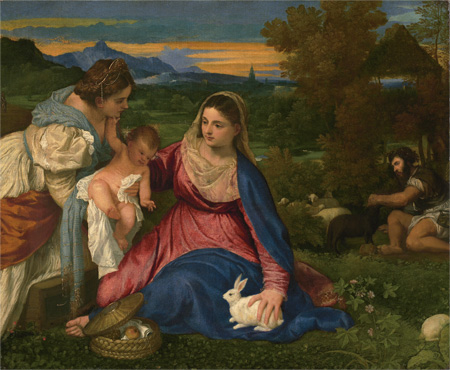|
|

 |
 |
The Virgin and Child with Saint Catherine and a Shepherd, known as The Madonna of the Rabbit
C. 1525 - 1530
Tiziano VECELLIO, known as Titian
Pieve di Cadore, 1488/1490 - Venice, 1576
Musée du Louvre, Paris
© 2007 Musée du Louvre / Angéle Dequier |
 |
 |
 |
| Painted in the 16th century by Titian, The Madonna of the Rabbit is on show for the first time in Japan. Usually displayed in the galleries dedicated to Venetian art, this painting is among the finest of the Louvre's Italian collections. This religious work, elegant in style, depicts a Christian scene amid the Venetian countryside dating from the artist's time. To understand the full richness of this painting, you are invited to study its iconography, its style, and its creator's life. |

 |
 |
Titian's Madonna of the Rabbit, on show here for the first time in Japan, is usually displayed on the first floor of the Musée du Louvre in the Salle des Etats, which houses Italian paintings from the 16th and 17th centuries.
When paintings are moved or sent out on tour, there are always five in particular that visitors to the Louvre miss, and complain they haven't been able to see! One of these is the Madonna of the Rabbit. |

 |
 |
| In the foreground of the painting figures drawn from various eras mingle, all of whom are characterized by holiness. Saint Catherine, who lived well after Jesus's time is holding the infant Jesus, whom she presents to Mary. The grouping of these figures around Mary is in fact due to the painting's genre. A Sacra Conversazione, or Holy Conversation, is being portrayed whereby various saints are brought together and depicted in reverent attitudes in order to obtain the salvation of the faithful from God and his son Jesus according to the Christian religion. First emerging in the 15th century, this type of work developed widely in Italian religious painting, particularly in a private context, as in The Madonna of the Rabbit. |

 |
 |
| With a keen sense of the country environment around Venice, Titian sets his Sacra Conversazione within verdant nature. This merging of the rural world and Christian themes is typical of early 16th-century Venetian painters. Of note are the rabbit - both a picturesque and symbolic element - and the shepherd in the background. The triumph of Christianity over paganism is apparent in the opposition of the shepherd, representing antiquity, with Mary. The basket of fruit recalls redemption from sin by Christ's death, and the wheel placed beneath Saint Catherine refers to her martyrdom. Each object appears to have a natural place in this majestic setting, to which the sunset over the mountains brings a note of harmony. |

 |
 |
| Titian (c.1490-1576) asserted himself as one of the most original painters of the 16th century through the subtlety of his brushwork and the forceful nature of his compositions. A brilliant portraitist and masterful portrayer of courtly mythologies or intensely religious scenes, he commanded a vibrant style from his youth through to his last works. Working mainly for Venice, he was also the favorite painter of Charles V, the most renowned monarch of the Renaissance. Admired as a prodigious colorist, Titian has influenced generations of artists from Tintoretto to Cézanne, including Rubens or Delacroix. |
|

